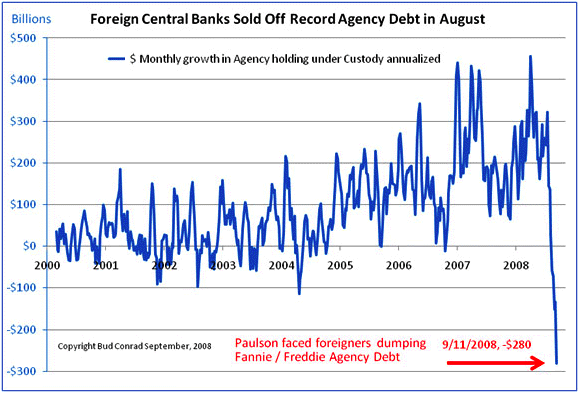 Casey Files: Casey Files:
A Horrible Mess, and How
We Got There
Olivier Garret, CEO
Casey Research - The
Casey Report
Sep 29, 2008
No one will deny that last
week was one of the most tumultuous in history. The streets red
with blood... the bodies of the dead and dying strewn about where
they fell.
You already know the names:
Lehman, Merrill, AIG. Fannie and Freddie.
But none of this happened by
accident.
The warning signs have been
all around us for years.
Bud Conrad, chief economist
at Casey Research, wrote about the beginnings of our current
problems back in March of 2007... before most people were even
aware of the storms brewing just over the horizon.
"Faced with historic
levels of debt, falling housing prices, and weaker economy, the
pressure on housing would gain momentum as desperate homeowners
either hand their keys back to the banks, or simply hit the bid
on the best (low) offer they can get. A vicious cycle would set
in, threatening to shove the economy into uncharted and unpredictable
waters.
"The impending calamity
- mass housing foreclosures, failing banks, Fannie Mae and Freddie
Mac in ashes, millions of personal bankruptcies - is so dire,
most people can't even conceive of it. And indeed, it may not
hit us this year, or next, but the market always corrects itself,
and this time will be no exception - sooner or later... That's
why the coming crisis is so predictable: there's no way to avoid
it."
I actually wish that his analysis
had been flawed.
I also wish that the government
officials had been right who have consistently claimed since
then that the subprime crisis was contained and the markets would
rebound in the second half of the year.
Unfortunately, this is not
the case.
The Fed's recent attempts at
quick fixes have not worked, and current events are reinforcing
what Bud Conrad prognosticated almost two years ago: that this
is much more than a normal cyclical correction. This is a disaster
of biblical proportions.
As the Fed and the Treasury
continue to intervene in the market, they continue to lose ground
and credibility, caught between a sharp recession and strong
inflationary pressures. In an effort to bail out the financial
sector, they have no choice but to start injecting hundreds of
billions in liquidity into a contracting market place.
This will contribute to the
creation of a stagflation period that will make the '70s look
like a tea party.
The Fed's never-ending injection
of liquidity into the market has, and will continue to,
devalue the dollar.
Ordinarily, a country threatened
with currency collapse would lean toward tight money, perhaps
contracting its domestic money supply. That would push interest
rates upward and compensate foreigners for holding on to the
currency despite the depreciation risk. And it would soften that
risk.
But this time, things aren't
ordinary... there is a difference that has turned what might
otherwise be a disturbance into a disaster: the U.S. economy's
inability to endure high interest rates.
Because of the corrections
taking place now in the grossly distorted U.S. housing, commercial
real estate, and personal credit markets, raising interest rates
to protect the dollar would prove as calamitous as not
raising interest rates.
The housing bubble fueled a
blockbuster business in first mortgages, and then home equity
loans. Homeowners drew down their equity to splurge on consumer
goods, including shiploads of imports.
The relative attractiveness
of U.S. financial instruments kept the game going into overtime.
The foreigners who received all those U.S. dollars put them back
into U.S. Treasury bills and other dollar-denominated instruments,
thereby underwriting low interest rates for all U.S. borrowers.
The net result? Foreigners
funded our housing boom. The amount of mortgage growth annually
matched the amount of trade deficit, which foreigners dutifully
invested back into the U.S.
And subprime lending was no
mere sideshow. It was big business. In 2005, it accounted for
25% of all new mortgages - about $600 billion of high-risk paper,
most of it with adjustable interest rates.
The collapse of the subprime
market soon spread into other mortgage sectors... and the derivatives
created on top of all those subprime mortgages made everything
much worse. Given that the annual GDP of the U.S. economy is
just $13 trillion, the $250 trillion in derivatives should have
been seen as an accident waiting to happen.
Foreign reinvestment is part
of the system of U.S. debt, and we are already seeing a significant
impact, as depicted in the chart below.

As foreign investors watched
the collapse of the U.S. housing markets, and the relative values
of their debts began to sink, they quickly moved out of U.S.
debt, particularly Fannie/Freddie obligations.
This massive exodus of foreign
cash out of the debt of Fannie/Freddie prompted the biggest stock
market fall since the days just after 9/11. On September 15,
2008, Treasury Secretary Paulson injected the biggest amount
of daily liquidity since 2001, a whopping $70 billion in just
one day.
And now the government is proposing
an additional infusion of approximately $1 trillion. More than
the total cost of the Iraq War.
To put this amount into perspective:
if you had spent $1,000,000 a day, from the birth of Christ until
today, you would have only spent about 732 billion
dollars.
It's going to be interesting
to see what happens to our markets if that proposal goes through.
***
If you had known all this was happening,
what would you have done differently?
If you had seen this coming,
you could have moved to protect yourself and your portfolio.
You could have shorted financials and bond insurers, like MBIA.
You could have played more in the gold fields.
But how could you know all this was going to happen?
We at Casey Research have long
foreseen what is unfolding right now... and those investors who
followed our recommendations made three- and four-digit returns.
We believe in making the trend your friend... otherwise it can
be a fearsome enemy.
Which is what The
Casey Report is all about - giving you the pertinent and
well-researched information on big economic trends unfolding
at this moment, and how best to invest to make them work for
you, instead of against you. Find out more about the power of
the trends, and about The Casey Report, by clicking
this link now.
Casey Archives
321gold Ltd

|